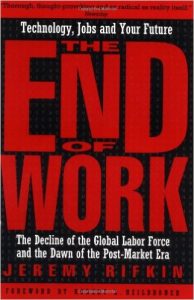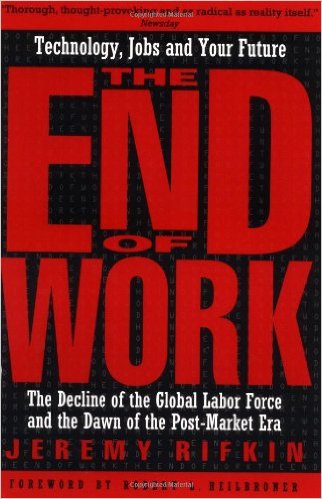I published an “End of Work as We Know It” piece back in 2015 for the Career Planning and Adult De velopment Journal. A quick Google search reveals I was not the only one with this idea – 17 other articles playing on this title (from the old REM “end of the world as we know it”) song turn up in the first three pages. It’s a hot topic right now. But it’s not a new one. One of the first books I remember reading on this was Jeremy Rifkin’s 1996: The End of Work: The Decline of the Global Labor Force and the Dawn of the Post-Market Era. Pretty remarkable that a book on that topic was not only written but seemed to be fairly popular. Maybe because it seemed to be talking about the very distant future. But here we are!
velopment Journal. A quick Google search reveals I was not the only one with this idea – 17 other articles playing on this title (from the old REM “end of the world as we know it”) song turn up in the first three pages. It’s a hot topic right now. But it’s not a new one. One of the first books I remember reading on this was Jeremy Rifkin’s 1996: The End of Work: The Decline of the Global Labor Force and the Dawn of the Post-Market Era. Pretty remarkable that a book on that topic was not only written but seemed to be fairly popular. Maybe because it seemed to be talking about the very distant future. But here we are!
Just to be clear, this book is about the end of work, not the end of capitalism we have been discussing. Nonetheless, it touches on many of the same themes. Put directly: “the wholesale substitution of machines for workers is going to force every nation to rethink the role of human beings in the social process.” He quickly segways into the social implications, noting that the resulting productivity gains from automation could lead to huge gains for some (today we say the 1%) and a huge inequality gap. And this gap could lead to social and political upheaval on a global scale.
He raised a point that often gets overlooked in the after capitalism discussion: “the metamorphosis of consumption from vice to virtue is one of the most important yet least examined phenomena of the twentieth century. Right! When we step back from this, it is truly bizarre that not only is consuming good, going into debt to support that consumption is as well. We have gotten to this strange place, and isn’t it interesting that we think it is the normal and proper way of things such that they cannot (and maybe should not) be reversed.
The challenge for the end of work is: redefining the role of the individual in a society absent of mass formal work is, perhaps, the seminal issue of the coming age. The solution is to create a vibrant third sector (public is 1st sector; market is 2nd sector; volunteer is third sector). Examples include social services to health care, education and research, the arts, religion, and advocacy, community service organizations. He also suggests what is now referred to as the basic income. He noted the role of futurist Bob Theobald in raising that issue, and how commission in the Johnson Administration considered it back in 1967.
I did note that his solution is still to create jobs, but just different ones for the third or civil sector. My thinking at this point is that creating enough jobs is trying to solve the problem within the paradigm, and we need a solution outside of it.
Now for the seemingly regular quibble about futurist bashing: “scores of futurists have written breathless tracts prophesying the end of history and our final deliverance into a techno-paradise mediated by free market forces.” If I remember right, he is referring to Francis Fukuyama, who was not a futurist. And….”academicians and futurists are pegged with pushing an emerging techno-utopia.” No sources of course. As we say, let’s not let that get in the way of a very useful and prescient work. Andy Hines

Leave a Reply